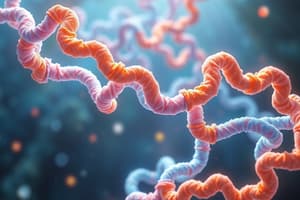Podcast
Questions and Answers
What is the term used to describe the three-dimensional arrangement of a protein's amino acid sequence?
What is the term used to describe the three-dimensional arrangement of a protein's amino acid sequence?
Which type of amino acid has nonpolar side chains that interact favorably with other nonpolar molecules?
Which type of amino acid has nonpolar side chains that interact favorably with other nonpolar molecules?
What is the primary function of proteins in biological systems?
What is the primary function of proteins in biological systems?
Which process is responsible for the production of proteins from genetic information encoded in DNA?
Which process is responsible for the production of proteins from genetic information encoded in DNA?
Signup and view all the answers
Which type of protein is responsible for catalyzing chemical reactions in biological systems?
Which type of protein is responsible for catalyzing chemical reactions in biological systems?
Signup and view all the answers
What is the primary structure of a protein?
What is the primary structure of a protein?
Signup and view all the answers
What is the role of peptide bonds in protein structure?
What is the role of peptide bonds in protein structure?
Signup and view all the answers
Which of the following is NOT a common secondary structure found in proteins?
Which of the following is NOT a common secondary structure found in proteins?
Signup and view all the answers
What is the role of the quaternary structure in proteins?
What is the role of the quaternary structure in proteins?
Signup and view all the answers
Which of the following is NOT a primary function of proteins in living organisms?
Which of the following is NOT a primary function of proteins in living organisms?
Signup and view all the answers
Study Notes
Protein: Structure, Amino Acids, Function, Synthesis, Types
Proteins are essential components of living organisms, performing various roles ranging from structural support to biological signaling. Understanding their structure, composition, and synthesis provides insights into their diverse functions and importance in our bodies.
Structure
Proteins are polymers composed of amino acids, forming long chains called polypeptides. These chains can be single or multi-chained, depending on the specific protein. The structure of a protein determines its overall shape and functional properties. There are four levels of protein structure: primary, secondary, tertiary, and quaternary.
Primary Structure
The primary structure refers to the sequence of amino acids in a protein. Each amino acid is connected to the adjacent amino acid by peptide bonds, which are covalent bonds formed between the carboxyl group of one amino acid and the amino group of another. The unique arrangement of these bonds determines the primary structure of the protein, which is crucial for its functionality.
Secondary Structure
Secondary structures are localized regions within a protein chain. Common secondary structures include alpha helices and beta pleated sheets, which are stabilized by hydrogen bonds between amino acids. These conformations contribute to the overall tertiary structure of the protein.
Tertiary Structure
The tertiary structure describes the three-dimensional arrangement of a protein's amino acid sequence. Interactions between amino acids and their side chains lead to the folding pattern that gives the protein its characteristic shape. This structure is vital for the protein's function and interaction with other molecules.
Quaternary Structure
Some proteins have a quaternary structure, where multiple polypeptide chains associate to form a functional unit. This can involve noncovalent interactions between protein domains, allowing for additional complexity and specialized functions.
Amino Acids
There are 20 naturally occurring amino acids in proteins, which can be classified according to their chemical properties.
Nonpolar Amino Acids
Glycine, alanine, valine, leucine, isoleucine, methionine belong to this category. These amino acids have nonpolar side chains that interact favorably with other nonpolar molecules.
Polar, Uncharged Amino Acids
Serine, threonine, asparagine, glutamine, proline, and cysteine fall into this category. These amino acids have polar side chains that can participate in hydrogen bonding, contributing to the overall structure and stability of the protein.
Acidic Amino Acids
Aspartic acid and glutamic acid have negatively charged side chains, while histidine and arginine have positively charged side chains. These amino acids can participate in electrostatic interactions and help regulate the protein's charge and overall stability.
Function
Proteins perform numerous functions in biological systems, including catalysis, signal transduction, transportation, and structural support. Their unique structures enable them to carry out these tasks efficiently and with high specificity.
Protein Synthesis
Protein synthesis involves the production of proteins from genetic information encoded in DNA. The process consists of transcription (DNA to RNA copying) and translation (RNA to protein assembly). The sequence of amino acids in a protein is determined by the order of codons in the messenger RNA (mRNA), which corresponds to the nucleotide sequence of the protein-coding gene.
Types
Proteins can be classified based on their function or structure. Some examples include enzymes (catalytic proteins), antibodies (immune system proteins), hormones (signaling proteins), structural proteins (supporting tissues), and carrier proteins (transport proteins). Within these categories, there are further distinctions based on the protein's size, shape, and location within the cell.
Studying That Suits You
Use AI to generate personalized quizzes and flashcards to suit your learning preferences.
Description
Test your knowledge on the structure, composition, synthesis, and functions of proteins. Explore the levels of protein structure, the classification of amino acids, the diverse roles proteins play in living organisms, and the process of protein synthesis from DNA to functional molecules.




